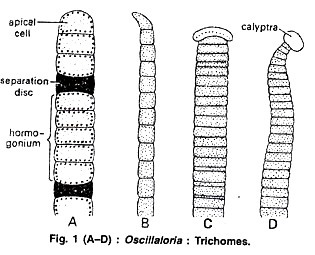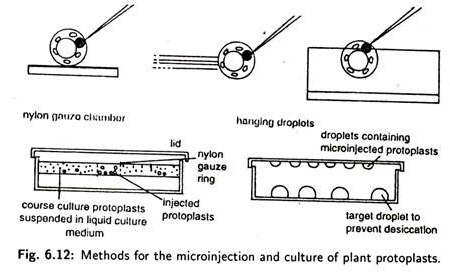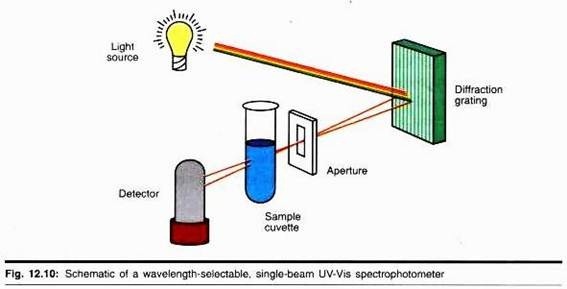In this article we will discuss about:- 1. Occurrence of Oscillatoria 2. Thallus Structure of Oscillatoria 3. Cell Structure 4. Reproduction 5. Movement.
Occurrence of Oscillatoria:
Oscillatoria, a fresh water, blue green alga, is represented by 76 species. Species are commonly found in fresh and polluted water of ponds, pools, drains, streams, and also in damp soils and rocks. These form bluish scums on water surface or at pond-bottom.
O. princeps grows in sea water and sub-aerial habitats. O. brevis can separation bear a temperature of -16°C while O. terebriformis occurs in hot water springs (thermal algae). Some of saprophytic species are found in the digestive and respiratory tracts of the animals.
Thallus Structure of Oscillatoria:
It is an un-branched filamentous alga (Fig. 1A). Filaments may be either attached or free floating and rarely occur singly. In majority of the species they form compact tangle mass or spongy sheets. The filaments may be interwoven or arranged in parallel rows. The filaments are uniseriate each containing a single trichome the trichomes are usually naked and have a thin, poorly developed sheath.
They are usually smooth but sometimes constricted at the cross walls. Each trichome is an un-branched, long, flat thread like structure made up of numerous cells. The cells are broader than in their length and show prokaryotic organization.
Cell Structure of Oscillatoria:
All cells in the trichome are similar in structure. It can be differentiated into two parts: Cell wall and protoplasm.
Cell wall is made of mucopeptide. Ultra structurally it consists mainly a 2000 A structural layer external to plasma membrane. Outside the structural layer is 160° A° thick another layer and there is a third 90° A layer loosely wrapped around the two.
The structural layer has s series of 700 A° wide pores which terminate at the 160 A° layer. Under an ordinary microscope the protoplasm is distinguishable into a peripheral chromoplasm and a central colourless centroplasin or central body.
Ultrastructure of cell shows that the chromoplasm contains photosynthetic lamellae or single thylakoid which often run parallel to one another. The thylakoids contain photosynthetic pigments like chlorophyll a, carotenes, xanthophyll’s and phycobilins (C-phycocyanin, allophycocyanin, c-phycoerythrin).
Phycobilins occur in minute vesicles called phycobilisomes. The centroplasm represents the incipient nucleus called gonophore. It is represented by DNA fibrils. The cell contains many ribosomes but mitochondria, plastids, ER and Golgi bodies are absent.
Reserve food material is in the form of cyanophycean starch, lipid, globules and cyanophycin. The protoplasm also contains two types of granules α and β α granules contain proteins and polysaccharides while (3 granules have lipid. Planktonic species of Oscillatoria possess gas vacuoles or pseudovaculoles which are devoid of any membrane. It is made of a number of ‘hexagonal’ structures called ‘gas vesicles’ (Fig. 2B).
The trichome shows polarity. It possesses characteristic apical cell. It may be cap like (capitate) or covered by a thick membrane called calyptra. The apical cell may also be conical, dome shaped, acuminate, oval, flattened convex or coiled and accordingly to the shape of the cap cell, the species are identified (Fig. 3 A-H).
Reproduction in Oscillatoria:
Oscillatoria reproduces only be vegetative methods.
These are:
1. By fragmentation:
It occurs due to accidental breakage of the filament, biting of some .insects or animals. Filament divides into small pieces or fragments. Each of these fragments is capable of developing into new individual.
2. By hormorgonia:
Hormogonia or hormogones are short segments of trichome which consists few cells. Hormogones are formed due to formation of separation discs. These discs are mucilaginous, pad like and biconcave in shape. These are formed by death of one or more cells of the filament. These mucilage filled dead cells are also called necridia.
Movement in Oscillatoria:
The name Oscillatoria (oscillare, to swing) is given to this alga due to the peculiar movement shown by the. trichome. It is called ‘oscillatory movement’. These are the jerky, pendulum-like
movements of the apical region of the trichome.
Some other movements shown by the trichomes of Oscillatoria are:
Gliding or creeping movement:
The trichome moves forward and backward along its long axis.
Bending movement:
The tip of the trichome shows bending.



